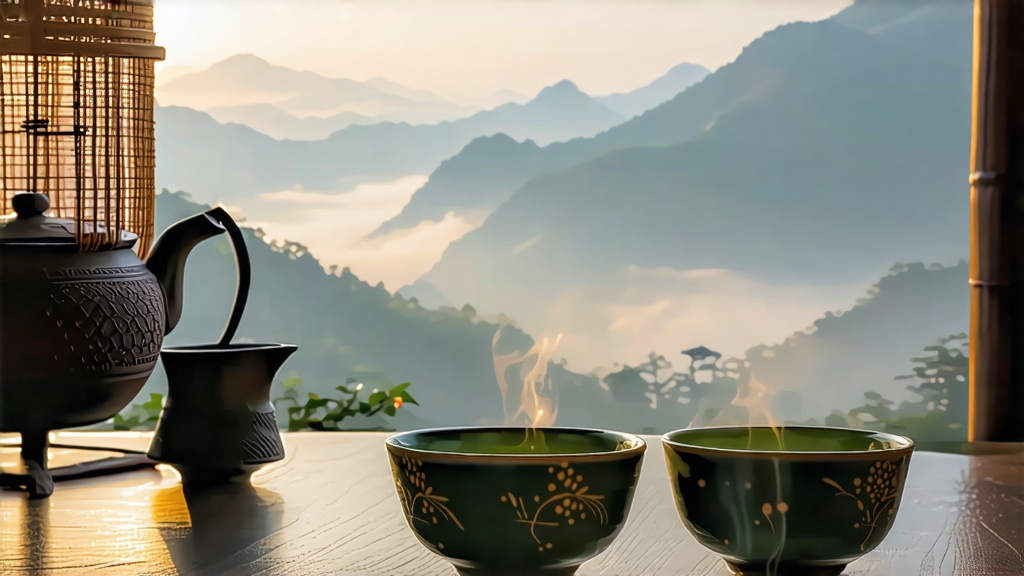
Meng Ding Huang Ya, literally “Yellow Bud from Meng Mountain,” is the least-known yet most aristocratic member of China’s yellow-tea family. While green tea commands the world’s attention and pu-erh fills collectors’ vaults, this luminous, down-covered bud has quietly survived thirteen centuries on the same mist-wrapped ridges where it first charmed a Tang-dynasty emperor. To understand it is to witness a living time-capsule of Chinese restraint: a tea that pauses on purpose, breathes in its own warmth, and emerges neither green nor black but glowing like polished amber.
History: from elixir to exile
Meng Mountain rises just north of Ya’an in Sichuan Province, the historic gateway between the Sichuan Basin and the Tibetan Plateau. Buddhist monks planted the first tea gardens here around 50 CE, claiming the altitude—1,400 m above sea level—brought them closer to the “heavenly aroma” described in the Lotus Sutra. By 724 CE the Tang court had declared Meng Ding tea a “tribute of the first rank,” demanding the first eighty buds of spring be couriered 1,800 km to Chang’an within nine days so the emperor could “taste the mountain clouds.” The Song dynasty tightened the monopoly; only the emperor’s seal could unlock the mountain gates during plucking season. When Ming tea masters invented the slow “sealed yellowing” step around 1550, Meng Ding buds were the first material honored with the new craft, and the name Huang Ya—“yellow bud”—entered the lexicon. The Qing court doubled the tribute quota, but the 1911 revolution scattered the artisans; by the 1970s the technique survived in a single courtyard with three elderly masters. A 1983 government restoration project brought the tea back from extinction, yet annual production today is still under 1,200 kg, making authentic Meng Ding Huang Ya rarer per gram than silver.
Terroir: where clouds polish the buds
The mountain’s spine catches both the Sichuan fog and the cold Himalayan down-draft, creating a 90 % average humidity that acts like a natural sauna for tea leaves. Day-night temperature swings of 15 °C slow photosynthesis, doubling the amino acid pool and giving the buds their signature “sweet corn milk” aroma. Soils are Devonian sandstone leached by constant drizzle, acidic (pH 4.8) yet laced with selenium and zinc that the old growers call “mountain salt.” Only the indigenous small-leaf cultivar Meng Ding #9 is permitted; its leaves are the size of a sparrow’s tongue, perfect for enclosing the downy bud without tearing during the twisting stage.
Plucking: one bud, one dew, one breath
The harvest window opens between Qingming and Grain Rain—usually 10 to 20 April—when the bud stands 18–22 mm long but has not yet unfurled into a leaf. Pickers climb 4 a.m. bamboo ladders wearing hemp gloves so skin oils never touch the shoot. Each pluck is a snap, not a pull, leaving the tiny “fish-tail” stem intact; this micro-stem becomes the conduit for moisture during yellowing. The daily quota for an experienced picker is 400 g fresh buds, barely enough to yield 100 g finished tea.
Craft: the art of controlled suffocation
Yellow tea’s defining step is men huang—“sealed yellowing”—a controlled enzymatic suffocation that must be coaxed, not forced. Within two hours of plucking the buds are spread on goat-hair mats and wok-fired at 85 °C for 90 seconds, just long enough to kill the grass-green enzymes but preserve the down. While still warm they are wrapped in steamed rice-paper bundles the size of a fist; these bundles rest inside a bamboo box lined with wet cotton. For the next 48 hours the tea master opens the box every three hours to release CO₂, feel the buds, and adjust the cotton moisture. If the pile smells like fresh pineapple, the yellowing is on track; if it drifts toward jackfruit, the temperature is too high and the batch is salvaged by a quick re-fire. When the buds have turned the color of polished wheat and feel like wet velvet, they are given a final low-temperature bake at 60 °C for 30 minutes, then cooled inside hollowed-out pomelo skins overnight to absorb a whisper of citrus. The entire process consumes five days and reduces the mass by 70